THE
MICRORGANISMS
|
|
They
are invisible organisms to the naked eye. The bacteria
belong
to the Prokariotes' kingdom , the protozoa to
Protists, the leaven and the mildews belong to Fungi.
The viruses are considered neither living neither not living
things, because they live and are reproduced only inside
the cells that they infect.
|
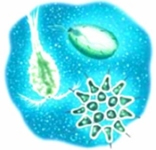
|
The
bacteria
The
bacteria are unicellular microorganisms. They are very
important because they are responsible for the decomposition
of the organic matter in mineral
substances.
Plants utilize the minerals for the photosynthesis and reintroduce
them in the alimentary cycle.
|
|
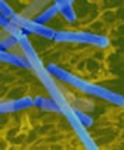
|

|
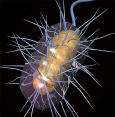
|
The
shape
The
bacteria diameter is between 1 and 10 micrometers. The
bacterial cell is encircled by a cellular membrane and
by a cellular wall, a rather rigid covering that protect
it. Many bacteria surfaces are provided with one or more
filaments (the flagellums) that allow them to move.
If the bacterium has a round shape is called coccus, if it has a shape like a
rod is called bacillum, tif it has a spiral shape is called spirillus.
|
|

|
Where
they live
The bacteria live everywhere: in the land, in the water, in the air,
on the surface or inside the body of other organisms.
Often they live in colonies. If they need oxygen for
living are called aerobic, if not they are called anaerobic.
|
The
reproduction
The bacterial
multiplication happens in asexual way through binary
division:
1. the
DNA doubles itself inside the cell, forming a new chromosome,
that sticks to the cellular membrane
2. the
cell divides itself forming
two cells with the same genetic patrimony of the mother
cell
|
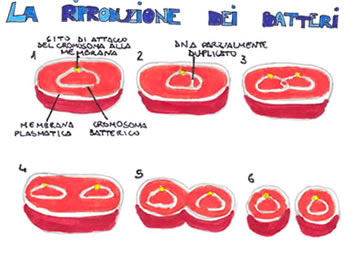
|
The
useful bacteria
The
bacteria are very useful not only for the men but also
for all the living beings. The decomposers decompose
the dead organisms transforming, by means of fermentation
processes, the complex substances in simple, mineral
substances that are reused by the plants and return in cycle.
This ability to transform organic substances is used for the depuration of waters.
Some bacteria improve the fertility of the soil because they live in symbiosis
with the plants (Leguminosae) and transform the atmospheric nitrogen in a chemical
substance that can be used by the plants.This process is called "nitrogen fixation ".
Other useful bacteria live in the stomach of ruminants and allow the digestion
of the vegetable fibers. Whitout they the cows and the sheeps couldn’t
digest the grass and the hay.
Many bacteria are fundamental in the fabrication of various useful products for
the men, such as foods, medicinal and other chemical products. The cheese, the
butter and the yogurth derive from the fermentation of the milk made by bacteria.
Thanks to the bacteria, substances of remarkable importance such as the alcohol
and the antibiotics (like the streptomicina and the tetraciclina) can be produced
on industrial scale.
|
The
harmful bacteria
The
harmful bacteria cause most serious diseases such as
tuberculosis (supported from the Mycobacterium tuberculosis),
meningitis, cholera (Vibrio comma), typhus and
tetanus. Until a century ago, the humanity was afraid
for these diseases that were spreaded quickly and caused
the death of thousand of people. Only at the end of the
XIX century, thanks to the work of Louis Pasteur and
of the German doctor Robert Koch, the bacterial origin
of these diseases was discovered.
|
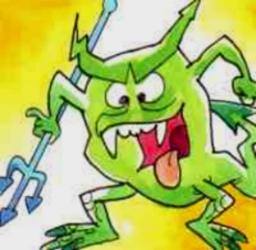
|
The
fermentation
Fermentations
are natural phenomena that the men learnt to control
and to reproduce.
For example the wine and the beer are produced through the fermentation. The
wine is made with the grape pressed in the vats and transformed in a mesh that
after a short time begins to boil; the sugar of the grape becomes alcohol while
carbon dioxide developes. The beer is produced from the barley in a similar way.Also
the yogurth and the cheeses are produced by the fermentation. The flour worked
with water and yeast and then cooked become bread.
|
TRANSFOR-
MATION
|
MICRO-
ORGANISMS
|
USED SUBSTANCES
|
PRODUCED SUBSTANCES
|
EXAMPLES
|
|
alcoholic
fermentation
|
yeast
|
starch, sugars
|
ethanol, carbon dioxide
|
grape > wine;
malt > beer;
flour and water> leavened
paste;
sugar and water > foam and gas;
banana > fermented banana
|
|
lactic fermentation
|
yeast
|
milk sugar
|
lactic acid
|
milk > fermented milk ;
milk >yogurth
|
|
mouldy
growth
|
mildews
|
several ( oxygen necessary))
|
several
|
bread > mouldy bread;
lemon,
orange > moldy lemon, orange
|
|
putrid
fermentation
|
bacteria
|
proteins
|
amino acids, water, ammonia,
carbon dioxide etc.
|
meat > putrid meat;
fish > putrid fish
|
|
acetic
fermentation
|
bacteria
|
ethanol
|
vinegar
|
wine >vinegar
|
|
|

